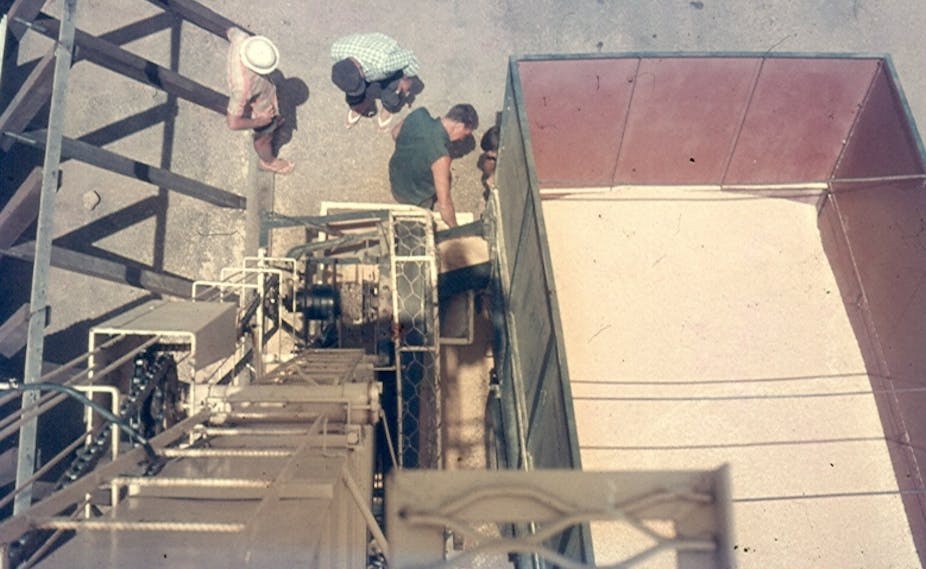Changing climate, drought and urban expansion threaten the yield of Australia’s wheat. But changes in cropping methods could address reduced water and lead to a jump in yield not seen since the late 1980s.
A history of innovation
The average yield of Australia’s dominant grain crop, wheat, changed little during the 1960s and 1970s. Then, from the mid-1980s to the turn of the century, three changes almost doubled the average wheat yield in south-eastern Australia.
The first of these was the idea of “water-limited yield potential”. A benchmark was set: a crop should produce about 20kg of grain per hectare for every millimetre of water that it used. This idea was rapidly embraced by the farming community for it provided an easily understood benchmark against which farmers could compare the performance of their crops. Average yields were less than half of that and there was much enthusiasm for finding out why.
The second change was canola’s introduction into the cropping system. Farmers soon noticed that the yield of wheat was substantially greater if it was grown after canola, rather than after other crops. The presence of canola roots in the soil greatly diminished the vigour of previously unrecognised root diseases. These root diseases had resulted in unreliable responses to nitrogen fertiliser, which farmers had therefore been loath to apply.
The third change was the increasingly rapid uptake of conservation farming techniques. Thanks to new and effective herbicides, tillage was no longer required to kill weeds. Farmers could sow crops without cultivating the soil, and this meant that sowing could be much more timely. It also left the soil much softer.
These three changes gave farmers a deeper practical insight (backed up by agronomic research) into what was limiting the yield of their wheat crops. This gave them the confidence to aim for higher yields by adding more fertiliser.
Drought a setback, but early sowing stepped in
This period of rapid growth came to an abrupt end during the millennium drought. Nevertheless, the farmers managed to maintain remarkably good yields during this time, except for two very tough years. How did they do it? By innovative management.
Farmers traditionally relied on autumn rainfall; thanks to the drought, there was much less of this. But there was more summer rainfall. Guided by agronomists, farmers conserved as much summer rain in the subsoil as they could.

They did so by meticulously controlling weeds and by retaining the stubble of the previous year’s crop as surface mulch. Controlling the weeds also made sure nitrates - mineralised from soil organic matter during wet periods - stayed in the soil to benefit future crops.
So, when autumn came around farmers had a guaranteed supply of water in the subsoil. But there was still the problem of getting the wheat to germinate and reach the moist subsoil. Farmers were anxious that the sparse autumn rain would provide few opportunities to sow.
Many sowed into dry soil, which, thanks to abandoning frequent cultivation, was now soft. In this they were largely successful.
Early sowing requires wheat varieties that develop slowly, for they must not flower before about late September, after the risk of frost damage has largely abated. Fortunately such varieties were available.
Making more use of less water
The general success of early sowing may benefit farmers as much as the changes of the late 1980s. Farmers might now hope for a much higher water-limited potential yield than in the 1990s, thanks to the capture of summer rainfall (and released nitrate) for use by the following crops, the greater potential yield resulting from the longer period available for developing floral structures that produce grain, and the time available to develop deeper roots for capturing valuable water from deep in the subsoil during grain-filling.
If the crops can use more of the annual rainfall (not just that in the growing season), and get a greater grain yield per millimetre of that extra water, yield could go up by 25%.
This prospect may be reinforced by new cultivars that will let farmers sow seeds much more deeply, deep enough for them to be sown directly into the moist subsoil. The problem with the current cultivars is their short coleoptiles. A coleoptile is the strong tube that emerges from a germinating grass seed and grows towards the soil surface while protecting the soft first leaf within it.
Coleoptiles of current wheat cultivars usually do not grow longer than about 5cm, so the seeds must be sown no deeper than this. New breeding lines have coleoptiles that can grow as long as 15cm.
Other options showing promise are dual purpose cultivars (they can be productively grazed during the winter as well as producing good grain yields); the use of “controlled traffic” so that any soil compaction is restricted to a small area because all machinery uses the same tracks; and precise GPS-guided sowing which lets crop seedlings get better established.
The near doubling of wheat yield during the late 1980s and 1990s was unpredicted, and perhaps unpredictable. But the omens are good for another period of substantial increases in wheat yield despite (and even because of) the recent volatility of weather patterns.

